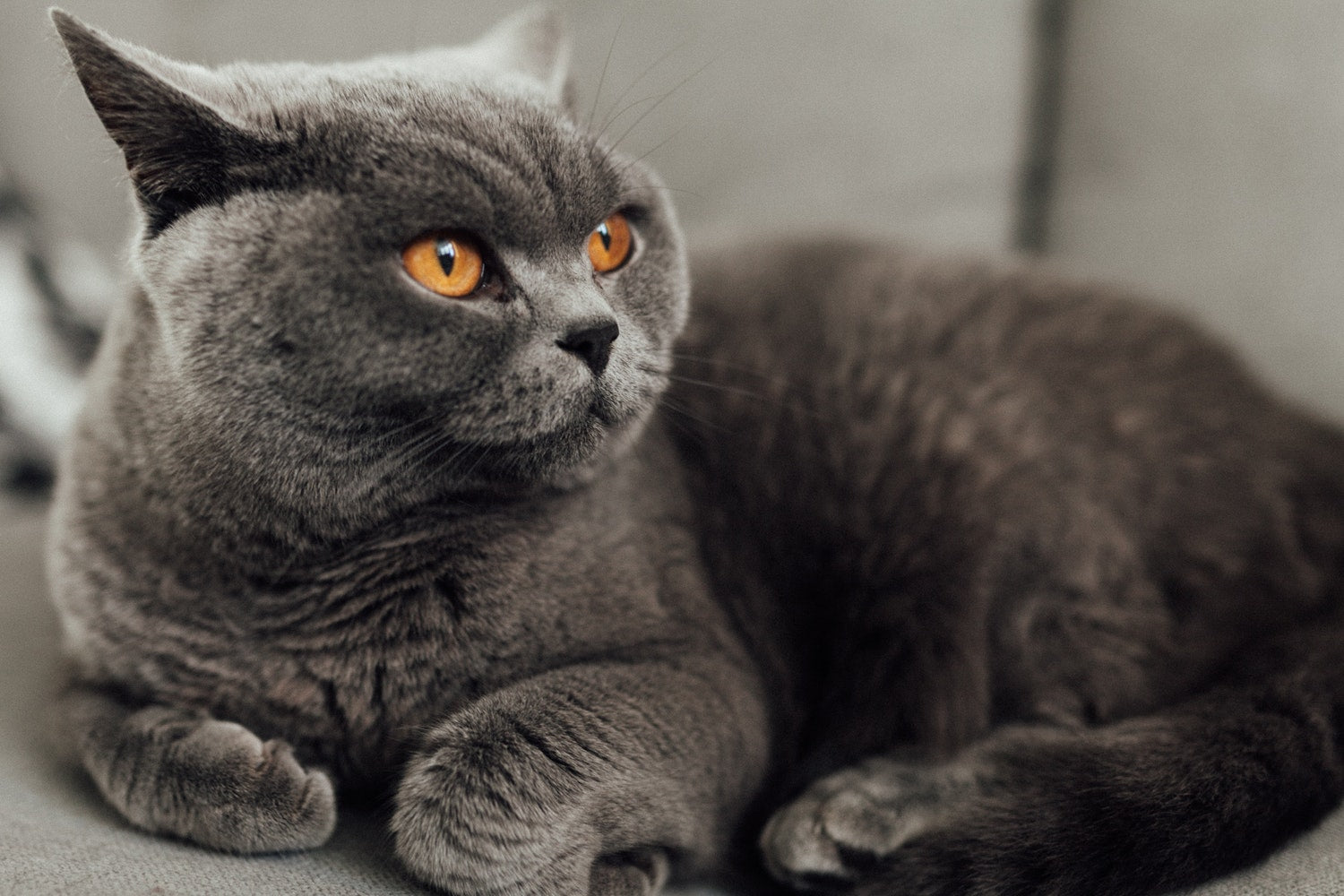
The most popular pedigreed breed in its native country, the British Shorthair cat is widely recognized for its well-behaved nature and sweet personality. The handsome looks and calm temperament of this kitty make them frequent media stars. While they are not hypoallergenic, they make a great pet nonetheless.
The most notable appearance of the breed was in Alice in Wonderland, as the Cheshire Cat. The Cat Fanciers' Association profile for the breed reads: "When gracelessness is observed, the British Shorthair is duly embarrassed, quickly recovering with a 'Cheshire cat smile'". Ladies and gents, please meet the British shorthair cat!
Main features of British Shorthair cats
What do British shorthair cats look like? They're distinct from the traditional British domestic cats by a characteristically chunky body, broad head, and dense coat. They are large, strong and not very graceful. Male cats are notably larger than females and often develop prominent jowls. They weigh from 9 to 17 lb, while females can weigh anywhere from 7 to 12 lb.
It can take up to three years of age for the British shorthair to reach complete physical development.
The most common coat color among this breed is the "British Blue", but the breed has developed a wide range of coat colors and patterns. The colors can vary from black, white, blue, red, cream, silver, golden to cinnamon and fawn. All patterns are allowed too, including tabby, bicolor, color-point and shaded. The texture of the fur is plush and it breaks into a characteristic "crisp" pile as the cat moves.

British Shorthair cats: Breed origins
The British Shorthair is considered to be one of the most ancient identifiable cat breeds in the world. The British Shorthair shares common ancestry with the native wild cats of Britain and were first introduced to the United Kingdom by the Romans. It is thought that Romans brought Egyptian domestic cats to Great Britain, where they then interbred with local European wildcats. Over time, the descendants naturally isolated and formed a new, large and robust cat that adapted to the conditions of the islands.
The British Shorthair was considered to have originated in the 1870s, as it was showcased in the very first cat show organized by Weir and held at the Crystal Palace in London in 1871. Towards the end of World War II, the British Shorthair began to drastically decline in numbers. Thus, in order to salvage and recreate the breed, breeders began crossing it with other breeds such as the Persians, Russian Blues, and Burmese. After the War, in order to maintain the breed, the Governing Council of the Cat Fancy decided to accept only third-generations of outcrosses of British Shorthairs with Persians.

Health conditions associated with British Shorthair cats
Unfortunately, recent genetic evidence suggests that the British Shorthair can be genetically predisposed to polycystic kidney disease and hypertrophic cardiomyopathy. Polycystic kidney disease is the gradual degeneration of the kidneys which leads to their failure, whereas hypertrophic cardiomyopathy is a form of heart disease that results in the abnormal thickening of the heart muscle.
A Danish study from 2011 that included more than 329 cats showed that 20.4% of males and 2.1% of the females had HCM. On top of this 6.4% of males and 3.5% of females were judged to be equivocal (Granström S. et al, 2011).
Personality
Nothing describes a laid back, quiet, and slightly lazy cat better than British Shorthair. These cats are the typical "lap cats" who absolutely love to cuddle up with their favorite hoomans. British Shorthairs are docile by nature and can make a great companion for anyone seeking a low-maintenance cat. They get along very well with children and cat-friendly dogs. Females tend to be more serious than males who are often silly in nature. British Shorthairs are highly intelligent and they interactive toys.

Did you know?
1. "The father of Cat Fancy" loved the British Shorthairs. As mentioned above, the breed was showcased in the very first cat show organized by Harrison Weir in 1871. The show also included Persians and Siamese cats, but, supposedly, Weird preferred his country's native breed. "My first love will always be for the short-haired domestic cat", wrote Weird in Our Cats and All About Them (1889).
2. They were the inspiration for the infamous Cheshire cat. Some historians think that Lewis Carroll's Cheshire cat was inspired by a tabby British Shorthair.
3. They can get a bit chubby. Although naturally large, British Shorthairs have a tendency toward obesity. In fact, PetMD recently listed the British Shorthair as one of its "top 10 fat cats."
4. A British Shorthair once held a record for the World's loudest purr. In 2011, the purr of a cat named Smokey was measured at 67.7 decibels, which is reported to be as noisy as a lawnmower. Sadly, Smokey died in 2014, but he held his record until 2015. In 2015, a cat named Merlin broke his record with a 67.8 decibel purr.

British Shorthair cats are docile, patient and sweet kitties who will make purrfect companions to a family with kids and cat-friendly dogs. They are good-natured, highly intelligent and just a bit lazy. Would you like to read about other pawsome cat breeds? Follow the tags below to explore more stories.
Reference
Granström, S.; Nyberg Godiksen, M. T.; Christiansen, M.; Pipper, C. B.; Willesen, J. T.; Koch, J. (2011). "Prevalence of Hypertrophic Cardiomyopathy in a Cohort of British Shorthair Cats in Denmark". Journal of Veterinary Internal Medicine. 25 (4): 866–871.
